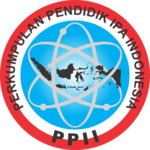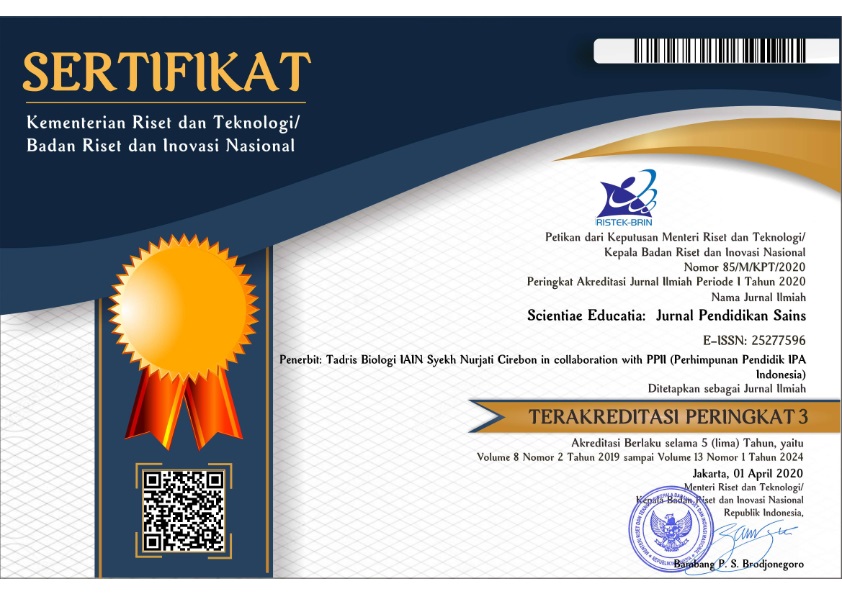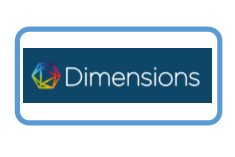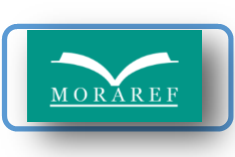Profile of Students' Reasoning Levels Using Ranking Task Exercises in Physics Learning
(1) Department of Islamic Education Management, Faculty of Tarbiyah and Teacher Training, UIN Alauddin Makasar
(2) Department of Physics Education, Faculty of Tarbiyah and Teacher Training, UIN Alauddin Makasar
(3) Department of Physics Education, Faculty of Tarbiyah and Teacher Training, UIN Alauddin Makasar
(*) Corresponding Author
Abstract
Keywords
Full Text:
PDFReferences
Abdurrahman, D., & Efendi, R. (2013). Siswa Sma Dalam Pembelajaran Fisika Berbasis Ranking Task Exercise Peer Instruction. 1, 84–91.
Akmam, A., Anshari, R., Amir, H., Jalinus, N., & Amran, A. (2018). Influence of Learning Strategy of Cognitive Conflict on Student Misconception in Computational Physics Course. IOP Conference Series: Materials Science and Engineering, 335(1). https://doi.org/10.1088/1757-899X/335/1/012074
Bao, L., Cai, T., Koenig, K., Fang, K., Han, J., Wang, J., Liu, Q., Ding, L., Cui, L., Luo, Y., Wang, Y., Li, E., & Wu, N. (2009). Physics: Learning and scientific reasoning. Science, 323(5914), 586–587. https://doi.org/10.1126/science.1167740
Bao, L., & Koenig, K. (2019). Physics education research for 21st century learning. Disciplinary and Interdisciplinary Science Education Research, 1(1), 1–12. https://doi.org/10.1186/s43031-019-0007-8
Bao, L., Xiao, Y., Koenig, K., & Han, J. (2018). Validity evaluation of the Lawson classroom test of scientific reasoning. Physical Review Physics Education Research, 14(2), 20106. https://doi.org/10.1103/PhysRevPhysEducRes.14.020106
Blumer, L. S., & Beck, C. W. (2019). Laboratory courses with guided-inquiry modules improve scientific reasoning and experimental design skills for the least-prepared undergraduate students. CBE Life Sciences Education, 18(1). https://doi.org/10.1187/cbe.18-08-0152
Burais, L., Ikhsan, M., & Duskri, M. (2020). Peningkatan Kemampuan Penalaran Matematis Siswa melalui Model Discovery Learning. 6(2), 77–86.
Cavallo, A. M. L., Rozman, M., Blickenstaff, J., & Walker, N. (2002). Learning, Reasoning, Motivation, and Epistemological Beliefs: Differing Approaches in College Science Courses. Journal of College Science Teaching, 3(33), 17–23.
Coelho, R. L. (2009). On the Concept of Energy: How Understanding its History can Improve Physics Teaching. Science & Education, 18, 961–983. https://doi.org/10.1007/s11191-007-9128-0
Erlina, N., Susantini, E., & Wasis, W. (2018). Common False of Student’s Scientific Reasoning in Physics Problems. Journal of Physics: Conference Series, 1108(1). https://doi.org/10.1088/1742-6596/1108/1/012016
Göhner, M., & Krell, M. (2020). Preservice Science Teachers’ Strategies in Scientific Reasoning: the Case of Modeling. Research in Science Education, Osborne 2013. https://doi.org/10.1007/s11165-020-09945-7
Handayani, G. A., Windyariani, S., Pauzi, R. Y., Biologi, P., Keguruan, F., Sukabumi, U. M., Syamsudin, J. R., No, S. H., & Cikole, K. (2020). Profil Tingkat Penalaran Ilmiah Siswa Sekolah Menengah Atas Pada Materi Ekosistem ( Scientific Reasoning Profile of Senior High School Students on Ecosystem Subject ). 6, 176–186. https://doi.org/10.22437/bio.v4i1.5508
Hudgins, D. W. (2005). Investigation of The Effect of Rangking Task On Students Understanding of key Astronomy Topic.
Hudgins, D. W. (2007). Effectiveness of Collaborative Ranking Tasks on Student Understanding of Key Astronomy Concepts. The Astronomy Education Review, 5(1).
Hung, W., & Jonassen, D. H. (2006). Conceptual Understanding of Causal Reasoning in Physics. International Journal of Science Education, 28(13), 1601–1621. https://doi.org/10.1080/09500690600560902
Khotimah, D. H. (2018). Profil kemampuan penalaran pada pembelajaran fisika siswa SMK Kabupaten Madiun. 25, 450–453.
Konita, M., Asikin, M., & Noor Asih, T. S. (2019). Kemampuan Penalaran Matematis dalam Model Pembelajaran Connecting, Organizing, Reflecting, Extending (CORE). PRISMA,Prosiding Seminar Nasional Matematika, 2, 611–615.
Krell, M., Khan, S., & Driel, J. Van. (2021). education sciences Analyzing Cognitive Demands of a Scientific Reasoning Test Using the Linear Logistic Test Model ( LLTM ).
Krell, M., Mathesius, S., Driel, J. van, Vergara, C., & Krüger, D. (2020). Assessing scientific reasoning competencies of pre-service science teachers: translating a German multiple-choice instrument into English and Spanish. International Journal of Science Education, 42(17), 2819–2841.
Krell, M., Redman, C., Mathesius, S., Krüger, D., & Driel, J. van. (2018). Assessing Pre-Service Science Teachers’ Scientific Reasoning Competencies. Research in Science Education, 2305–2329.
Kurniasih, O. Y., & Haerudin. (2019). Analisis Kesalahan Siswa Dalam Menyelesaikan Soal Cerita Materi Limit Fungsi Trigonometri. MATHEdunesa, 8(2), 228–232.
Mahler, D., Bock, D., & Bruckermann, T. (2021). Preservice biology teachers’ scientific reasoning skills and beliefs about nature of science: how do they develop and is there a mutual relationship during the development? Education Sciences, 11(9). https://doi.org/10.3390/educsci11090558
Md, M. R. (2019). 21st Century Skill “Problem Solvingâ€: Defining the Concept. Asian Journal of Interdisciplinary Research, 2(1), 64–74. https://doi.org/10.34256/ajir1917
Mulhayatiah, D., Suhendi, H. Y., & Oktaviani, V. (2017). Hubungan tingkat penalaran dengan hasil belajar mahasiswa melalui evaluasi teknik ranking task pada mata kuliah listrik magnet 1. WaPFi (Wahana Pendidikan Fisika), 2(1).
Musthafa, R. A., Sunardi, & Fatahillah, A. (2014). Analisis Tingkat Kemampuan Penalaran Siswa dalam Menyelesaikan Soal Cerita Materi FPB dan KPK Kelas VII B SMP Negeri 10 Jember ( Analysis of Level Students Reasoning Ability in Resolving Problems of The Story GCD and LCM State Class VII B Junior High Scho. Jurnal Edukasi, 1(3), 1–6.
Nguyen, D. H., & Rebello, N. S. (2011). Students’ understanding and application of the area under the curve concept in physics problems. Physical Review Special Topics - Physics Education Research, 7(1), 1–17. https://doi.org/10.1103/PhysRevSTPER.7.010112
Nizam. (2016). Ringkasan hasil-hasil asesmen: belajar dari hasil UN, PISA, TIMSS, INAP. Puspendik Balitbang Kemdikbud.
O’Kuma, thomas L., Maloney, D. P., & Hieggelke, C. J. (2004). Ranking Task Exercise in Physics: Student Edition Instructor’s Guide. Upper Saddle River.
OECD. (2016). PISA 2015 result in focus paris’. OECD Publishing.
Palloan, P., & Swandi, A. (2019). Development of learning instrument of active learning strategy integrated with computer simulation in physics teaching and learning on makassar state university. Journal of Physics: Conference Series, 1157(3). https://doi.org/10.1088/1742-6596/1157/3/032016
Purwana, U., Liliasari, & Rusdiana, D. (2016). Profil kompetensi awal penalaran ilmiah (scientific reasoning) mahasiswa pada perkuliahan fisika sekolah. Prosiding Simposium Nasional Inovasi Dan Pembelajaran Sains, 753–756.
Rahmawati, W. (2018). Pengaruh Pendekatan pembelajaran socioscientific issues (SSI) Pada model problem solving learning terhadap kemampuan berpikir kreatif peserta didik pada materi pencemaran air. Skripsi FKIP, Pendidikan Biologi, Universitas Muhammadiyah Sukabumi.
Retnawati, H. (2006). Validitas Realibilitas & Karakteristik Butir. Parama Publishing.
Sagala, R., Umam, R., Thahir, A., Saregar, A., & Wardani, I. (2019). The effectiveness of stem-based on gender differences: The impact of physics concept understanding. European Journal of Educational Research, 8(3), 753–761. https://doi.org/10.12973/eu-jer.8.3.753
Shen, W., Lin, Z., & Wang, H. (2020). The application of ranking task in mechanical engineering drawing teaching strategy. 2020 IEEE Learning With MOOCS (LWMOOCS).
Shodiq, F. (2004). Penalaran, Pemecahan Masalah, dan Komunikasi Dalam Pembelajaran Matematika. PPPG Matematika.
Siregar, N. (2019). Upaya Meningkatkan Kemampuan penalaran dan komunikasi matematis siswa melalui model Pace. Pedagogy : Jurnal Pendidikan Matematika, 4(2), 58–70. https://doi.org/10.30605/pedagogy.v4i2.1443
Sternberg, R. J., Wong, C. H., & Sternberg, K. (2019). The relation of tests of scientific reasoning to each other and to tests of general intelligence. Journal of Intelligence, 7(3). https://doi.org/10.3390/jintelligence7030020
Sukmadinata, N. S. (2014). Metode penelitian pendidikan. Remaja Rosdakarya.
Syafaat, E. M., Nurjannah, N., & Werdhiana, I. K. (2014). Penerapan model pembelajaran berbasis masalah menggunakan asesmen ranking task exercise (RTE) terhadap Pemahaman konsep hukum newton. JPFT (Jurnal Pendidikan Fisika Tadulako Online), 2(1), 49. https://doi.org/10.22487/j25805924.2014.v2.i1.2769
Utami, N., Mukhini, & Jazwinarti. (2014). Kemampuan Penalaran matematis siswa kelas XI IPA SMAN 2 Painan melalui penerapan pembelajaran think pair square. Jurnal Pendidikan Matematika, Vol 3(1), 7–12.
Wijaya, A. F. C., & Ramalis, T. R. (2012). Collaborative ranking tasks (crt) berbantuan e-learning untuk meningkatan keterampilan generik sains mahasiswa calon guru fisika. Jurnal Pendidikan Fisika Indonesia, 8(2), 144–151. https://doi.org/10.15294/jpfi.v8i2.2154
Wijaya, P. A. (2021). Mata Pelajaran Akuntansi. 1–16.
Zainuddin, Hasanah, A. R., Salam, M. A., Misbah, & Mahtari, S. (2019). Developing the interactive multimedia in physics learning. Journal of Physics: Conference Series, 1171(1), 12–17. https://doi.org/10.1088/1742-6596/1171/1/012019
Zulfaidhah, Z., Palenewen, E., & Hardoko, A. (2018). Needs analysis in the Problem Based Learning (PBL) Model Tools and Problems Regarding 7th Grade Students' Science Learning Outcome at SMPN 2 Bongan. BIODIK, 4(1), 48–59. https://doi.org/10.22437/bio.v4i1.5508
DOI: 10.24235/sc.educatia.v10i2.9153
Article Metrics
Abstract view : 15 timesPDF - 6 times
Refbacks
- There are currently no refbacks.
Scientiae Educatia: Jurnal Pendidikan Sains indexed by:

This work is licensed under a Creative Commons Attribution 4.0 International License.
Stat Counter (Link)



1.png)












